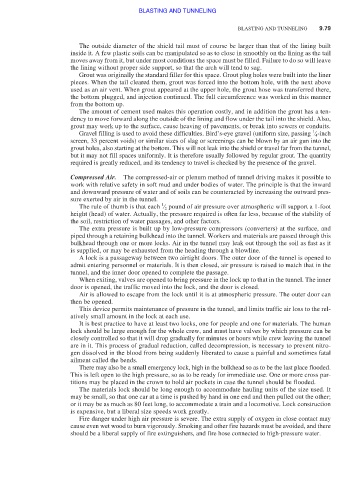Page 479 - Moving the Earth_ The Workbook of Excavation
P. 479
BLASTING AND TUNNELING
BLASTING AND TUNNELING 9.79
The outside diameter of the shield tail must of course be larger than that of the lining built
inside it. A few plastic soils can be manipulated so as to close in smoothly on the lining as the tail
moves away from it, but under most conditions the space must be filled. Failure to do so will leave
the lining without proper side support, so that the arch will tend to sag.
Grout was originally the standard filler for this space. Grout plug holes were built into the liner
pieces. When the tail cleared them, grout was forced into the bottom hole, with the next above
used as an air vent. When grout appeared at the upper hole, the grout hose was transferred there,
the bottom plugged, and injection continued. The full circumference was worked in this manner
from the bottom up.
The amount of cement used makes this operation costly, and in addition the grout has a ten-
dency to move forward along the outside of the lining and flow under the tail into the shield. Also,
grout may work up to the surface, cause heaving of pavements, or break into sewers or conduits.
1
Gravel filling is used to avoid these difficulties. Bird’s-eye gravel (uniform size, passing ⁄ 4 -inch
screen, 33 percent voids) or similar sizes of slag or screenings can be blown by an air gun into the
grout holes, also starting at the bottom. This will not leak into the shield or travel far from the tunnel,
but it may not fill spaces uniformly. It is therefore usually followed by regular grout. The quantity
required is greatly reduced, and its tendency to travel is checked by the presence of the gravel.
Compressed Air. The compressed-air or plenum method of tunnel driving makes it possible to
work with relative safety in soft mud and under bodies of water. The principle is that the inward
and downward pressure of water and of soils can be counteracted by increasing the outward pres-
sure exerted by air in the tunnel.
1
The rule of thumb is that each ⁄ 2 pound of air pressure over atmospheric will support a 1-foot
height (head) of water. Actually, the pressure required is often far less, because of the stability of
the soil, restriction of water passages, and other factors.
The extra pressure is built up by low-pressure compressors (converters) at the surface, and
piped through a retaining bulkhead into the tunnel. Workers and materials are passed through this
bulkhead through one or more locks. Air in the tunnel may leak out through the soil as fast as it
is supplied, or may be exhausted from the heading through a blowline.
A lock is a passageway between two airtight doors. The outer door of the tunnel is opened to
admit entering personnel or materials. It is then closed, air pressure is raised to match that in the
tunnel, and the inner door opened to complete the passage.
When exiting, valves are opened to bring pressure in the lock up to that in the tunnel. The inner
door is opened, the traffic moved into the lock, and the door is closed.
Air is allowed to escape from the lock until it is at atmospheric pressure. The outer door can
then be opened.
This device permits maintenance of pressure in the tunnel, and limits traffic air loss to the rel-
atively small amount in the lock at each use.
It is best practice to have at least two locks, one for people and one for materials. The human
lock should be large enough for the whole crew, and must have valves by which pressure can be
closely controlled so that it will drop gradually for minutes or hours while crew leaving the tunnel
are in it. This process of gradual reduction, called decompression, is necessary to prevent nitro-
gen dissolved in the blood from being suddenly liberated to cause a painful and sometimes fatal
ailment called the bends.
There may also be a small emergency lock, high in the bulkhead so as to be the last place flooded.
This is left open to the high pressure, so as to be ready for immediate use. One or more cross par-
titions may be placed in the crown to hold air pockets in case the tunnel should be flooded.
The materials lock should be long enough to accommodate hauling units of the size used. It
may be small, so that one car at a time is pushed by hand in one end and then pulled out the other;
or it may be as much as 80 feet long, to accommodate a train and a locomotive. Lock construction
is expensive, but a liberal size speeds work greatly.
Fire danger under high air pressure is severe. The extra supply of oxygen in close contact may
cause even wet wood to burn vigorously. Smoking and other fire hazards must be avoided, and there
should be a liberal supply of fire extinguishers, and fire hose connected to high-pressure water.

